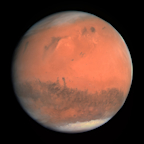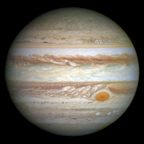Search results
Uranus is the seventh planet from the Sun. It is a gaseous cyan-coloured ice giant. Most of the planet is made of water, ammonia, and methane in a supercritical phase of matter, astronomy calls "ice" or volatiles.
Planet Uranus Overview. Uranus is the seventh planet from the Sun, and it's the third largest planet in our solar system – about four times wider than Earth. The diameter at its equator is 31,763 miles (51,120 kilometers). Uranus is a very cold and windy planet.
6 days ago · Uranus, seventh planet in distance from the Sun and the least massive of the solar system’s four giant, or Jovian, planets, which also include Jupiter, Saturn, and Neptune. At its brightest, Uranus is just visible to the unaided eye as a blue-green point of light. It is designated by the symbol ♅.
Uranus is a very cold and windy world. The ice giant is surrounded by 13 faint rings and 28 small moons. Uranus rotates at a nearly 90-degree angle from the plane of its orbit. This unique tilt makes Uranus appear to spin sideways, orbiting the Sun like a rolling ball.
Jun 13, 2024 · Uranus is an ice giant (instead of a gas giant). It is mostly made of flowing icy materials above a solid core. Uranus has a thick atmosphere made of methane, hydrogen, and helium. Uranus is the only planet that spins on its side. Uranus spins the opposite direction as Earth and most other planets. Time on Uranus.
Jan 17, 2017 · January 17, 2017. • 6 min read. Uranus, the seventh planet from the sun, may initially look like a bland, blue-green ball. But there's a lot to love about the icy giant, from its 13 rings to its...
The seventh planet from the Sun with the third largest diameter in our solar system, Uranus is very cold and windy. The ice giant is surrounded by 13 faint rings and 27 small moons as it rotates at a nearly 90-degree angle from the plane of its orbit.
Sep 26, 2019 · Uranus is the seventh planet from the Sun, around 1.8 billion miles or 2.9 billion kilometers distance away. It has the third-largest planetary radius and fourth-largest mass in the Solar System.
NASA/JPL-Caltech. Only one spacecraft has visited distant Uranus. After traveling more than 1.8 billion miles (3 billion kilometers) in nine years, NASA's Voyager 2 gathered much of its critical information about the mysterious planet, including its rings and moons, in just six hours.
Apr 6, 2023 · Following in the footsteps of the Neptune image released in 2022, NASA’s James Webb Space Telescope has taken a stunning image of the solar system’s other ice giant, the planet Uranus. The new image features dramatic rings as well as bright features in the planet’s atmosphere.



















